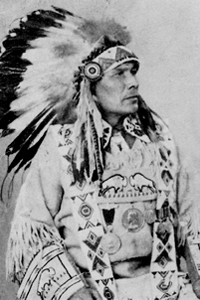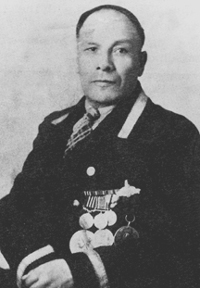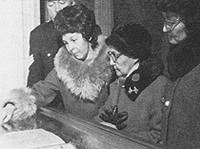Veterans Return

Chief Joe Dreaver of Saskatchewan's Mistawasis Cree Band. (Gladys Johnston)
The Indigenous people of Canada volunteered to serve in the Second World War for many of the same reasons as they had in the First. Economic hardship was a compelling factor, as one Métis Veteran explains:
Men couldn't get a job... In the army they paid a dollar-and-a-half [per day]. The most you could get around here for farming or whatever, was a dollar. A dollar-and-a-half sounded awfully good.57
Concern over spreading Nazism also prompted enlistment. Another Métis Veteran considered this ideology to be the greatest threat to the future of his people:
Our true destiny is not bound by the success or failure attendant upon Métis deliberation. . . . . It is bound up with our continued existence as Canadians who fight [for] those liberties to which we are all devoted and the preservation of which is dependent upon our victory.58
As in the First World War, recruiters visited reserves, occasionally under the direction of the local Indian Affairs representatives. Some Indigenous Veterans say they felt pressured to join.59
In addition, many Indigenous participants were strongly motivated by the stories fathers and uncles had told about their military experiences two decades prior. Several had even experienced global warfare first-hand.

In the First World War, Dreaver was a sapper, and earned the Military Medal in Belgium. He would lose two brothers to the fighting. Nevertheless, he signed on again during the Second World War, serving in Canada as a member of the Veterans Guard.(Gladys Johnston)
Chief Joe Dreaver of the Mistawasis Cree Band was one of many Indigenous people who served in both World Wars. During the first, he was a sapper who earned the Military Medal at Ypres. Although he had seen war's ugliest side, having lost one brother at Vimy Ridge and another at home from wounds received at Vimy, he did not hesitate to offer assistance when war erupted again.
Dreaver left his farm and drove 17 men from his reserve north of Leask, Saskatchewan, to Saskatoon to enlist. Three of the men were his own sons.60 Two of his daughters also served, and a younger brother went overseas as well. At 48, the chief himself was past the age for overseas service. He remained in Canada with the Veterans Guard, watching over prisoners of war in Medicine Hat, Alberta.61
Like the Dreaver family, the McLeods of Cape Croker, Ontario, made an extraordinary family sacrifice. John, an Ojibwa, served overseas in the First World War and was a member of the Veterans Guard during the Second. Six of his sons and one of his daughters also enlisted. Two sons gave their lives, and another two were wounded. In 1972, John's wife, Mary Louise McLeod, was named Canada's Silver Cross Mother. Mrs. McLeod became the first Indigenous woman to lay a wreath at the National War Memorial in Ottawa on behalf of all Canadian mothers who lost children to the wars.
The Second World War also saw Tom Longboat return to service, as a member of the Veterans Guard. He was stationed at a military camp near Brantford. His two sons, Thomas Jr. and Theodore, saw action for the first time. Though not with the army, Francis Pegahmagabow helped the war effort by working as a security guard for a defence industry near the Parry Island Reserve.

In 1972, as Canada's representative Silver Cross Mother, Mrs. Mary McLeod (centre) of Cape Croker laid a wreath at the National War Memorial. Mrs. McLeod lost two sons in the Second World War, another two were wounded. Here she and daughters Marie (left) and Lila examine the Books of Remembrance in the Memorial Chapel of the Peace Tower on Parliament Hill. (Legion Magazine)
- Date modified: